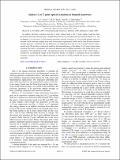| dc.contributor.author | Levin, A. J. | |
| dc.contributor.author | Black, M. R. | |
| dc.contributor.author | Dresselhaus, Mildred | |
| dc.date.accessioned | 2010-02-12T18:01:33Z | |
| dc.date.available | 2010-02-12T18:01:33Z | |
| dc.date.issued | 2009-04 | |
| dc.date.submitted | 2009-02 | |
| dc.identifier.issn | 1550-235X | |
| dc.identifier.issn | 1098-0121 | |
| dc.identifier.uri | http://hdl.handle.net/1721.1/51746 | |
| dc.description.abstract | An indirect electronic transition from the L point valence band to the T point valence band has been previously observed in Bi nanowires oriented along the [011̅ 2] crystalline direction (used by Black et al. and by Reppert et al.) but not in [112̅ 0]-oriented nanowires (used by Cornelius et al.) or in bulk bismuth. Here we measure the Bi nanowire samples from each of these prior experimental studies on the same Fourier transform infrared apparatus, confirming that the differences are indeed physical and are not associated with the experimental setup. We develop an analytical model for the threshold energy of the indirect L to T point valence-band transition that takes as parameters the nanowire diameter and crystalline orientation. Our model shows good agreement with experimental results, and demonstrates that the nonparabolic nature of the L point bands is essential for calculating the energy of this transition. Finally, we propose a mechanism based on symmetry lowering to explain why this indirect transition is observed for [011̅ 2]-oriented but not for [112̅ 0]-oriented nanowires. | en |
| dc.language.iso | en_US | |
| dc.publisher | American Physical Society | en |
| dc.relation.isversionof | http://dx.doi.org/10.1103/PhysRevB.79.165117 | en |
| dc.rights | Article is made available in accordance with the publisher's policy and may be subject to US copyright law. Please refer to the publisher's site for terms of use. | en |
| dc.source | APS | en |
| dc.title | Indirect L to T point optical transition in bismuth nanowires | en |
| dc.type | Article | en |
| dc.identifier.citation | Levin, A. J., M. R. Black, and M. S. Dresselhaus. “Indirect L to T point optical transition in bismuth nanowires.” Physical Review B 79.16 (2009): 165117. © 2009 The American Physical Society. | en |
| dc.contributor.department | Massachusetts Institute of Technology. Department of Electrical Engineering and Computer Science | en_US |
| dc.contributor.department | Massachusetts Institute of Technology. Department of Physics | en_US |
| dc.contributor.approver | Dresselhaus, Mildred | |
| dc.contributor.mitauthor | Levin, A. J. | |
| dc.contributor.mitauthor | Dresselhaus, Mildred | |
| dc.relation.journal | Physical Review B | en |
| dc.eprint.version | Final published version | en |
| dc.type.uri | http://purl.org/eprint/type/JournalArticle | en |
| eprint.status | http://purl.org/eprint/status/PeerReviewed | en |
| dspace.orderedauthors | Levin, A.; Black, M.; Dresselhaus, M. | en |
| dc.identifier.orcid | https://orcid.org/0000-0001-8492-2261 | |
| mit.license | PUBLISHER_POLICY | en |
| mit.metadata.status | Complete | |
